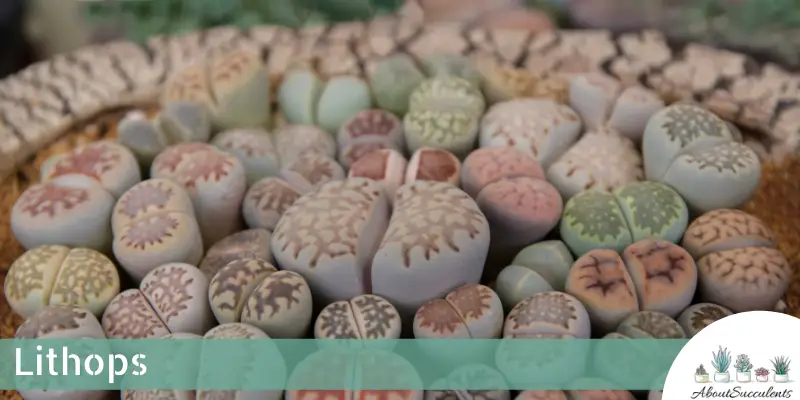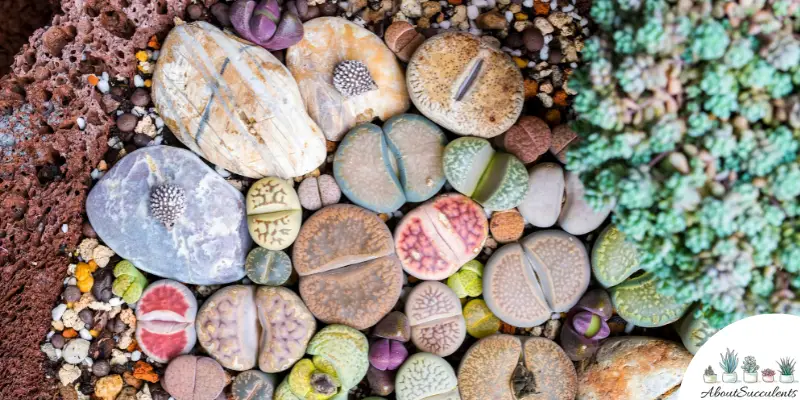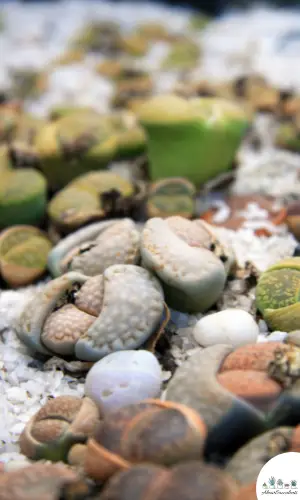
Lithops, more popularly known as Living Stones are near stemless plants with a pair of thick padded leaves and a central fissure. The leaves are translucent and are in various shades of green, gray, reddish-brown, and grass green.
These small succulents are adored for their unique appearance that resembles cloven hooves or clustered stones. They are very slow-growing plants that are mostly propagated from seeds and take almost a year to germinate.
Lithops hardly grow more than 2.5 cm (1.2”) tall and 2.5 cm – 7.6 cm (1”-3”) wide.
Living Stones bloom daisy-like diurnal flowers during late summer or fall. The flowers are golden yellow with a white center and can grow up to 3.3 cm (1.3”) in diameter.
Living Stones originate from the deserts of Southern Africa – Botswana, Namibia, and South Africa. They belong to the ice plant family, Aizoaceae.
General Information:
Also known as: Living Stones, Flowering Stones
Plant Family: Aizoaceae
Origin: Southern Africa
Height: 2.5 cm (1.2”)
Exposure: Full exposure to direct or indirect sun
Water Needs: Only when the soil is completely dry.
Soil Type: Quick-drying potting soil mixed with a lot of gritty materials such as perlite, pumice, sand, and fine lava.
Soil ph: 5 to 8
How to Grow and Care for Lithops

Lithops are low-maintenance succulents that can be grown indoors or outdoors as part of a rock garden. You just need to familiarize yourself with its watering routine to ensure that it will grow well in your home.
The ideal temperature for growing Lithops is between 20°C – 24°C (68°F – 75°F). Living Stones are somewhat cold-hardy but these succulent plants cannot thrive in temperatures that go below 12°C – 15°C (54°F-59°F)
Sunlight
Lithops’ natural habitat is classified as desert. These stone-like succulents can survive well with very little water. They can grow with exposure to direct or indirect sunlight.
It is best to set up your rock garden in an area where your Lithops can get direct or indirect morning sunlight for up to 6 hours a day. If it is exposed to full sunlight, check the soil for watering as it will lose moisture faster.
Indoors, it is best to place your pot on a window facing East, West, or South. Lithops need at least 4 to 5 hours of direct morning sunlight.
Take note that when Lithops do not get enough sunlight they will experience etiolation where the leaves will elongate and patterns will distort.
If your plant starts to lose its stone-like shape, it means it is getting too little light. Simply move it to a better location.
Watering
Remember to take it easy on the water especially during winter and summer. Overwatering will turn the leaves puffy and worse, the Lithops’ early demise as the roots will rot.
To keep your little succulents healthy, only water when the soil in the pot is entirely dry.
Check the dryness by inserting a wooden stick into the soil. If it comes out dry when removed, you can water the plant.
Lithops start growing new leaves during fall/autumn. It is best to water your Living Stones after the old leaves dry up and to stop watering when the flowers start to die.
After flowering, the old leaves provide water and nutrition to the new plant growing from within.
Pot and Soil
Ceramic and terracotta are the best pots to grow Lithops in because they allow moisture to escape freely. Living Stones have long roots. Make sure the pot is large enough to give the roots enough room to grow and to aerate the soil.
Living stones grow best in quick-drying potting soil or cactus mix. You can add sand, pebbles, pumice, or other materials that can help drain the soil faster.
Refrain from adding organic matter such as peat moss to prevent moisture retention. Lithops can thrive with little or no fertilizer. You can use a low nitrogen, high phosphorus fertilizer to induce flowering.
How to Propagate Lithops

Lithops are propagated from seeds or via the division of existing plants.
Method 1 – Seeds method
Step 1: Fill a pot with equal parts of fast-draining soil and gritty materials.
Step 2: Sprinkle the seeds evenly on the surface.
Step 3: Add a thin layer of sand, pumice, or fine lava.
Step 4: Moisten the top layer with a spray bottle for 7-14 days. The ideal temperature for lithops germination is between 18°C and 24°C.
You can cover the pot with transparent plastic to increase humidity levels for germination. If you live in an area with a humid climate, there is no need to cover the pot.
Remove the cover and reduce watering when germination starts. Keep your soil moist but not wet. Place your pot in an area where it can get enough sunlight, away from direct sunlight and any rain.
Method 2 – Division method
Step 1: Gently remove the lithops from the soil. You can use a spoon to scoop it out or empty the pot with the plant and soil to prevent root damage.
Step 2: Carefully brush off old dried skin and soil covering the roots.
Step 3: Trim the roots and leave your lithops on a dry towel for a few days before you repot it. This will allow the roots to callus over.
Step 4: Repot your lithops in fresh fast-draining soil mixed with gritty materials. The plant head should be sitting at a surface level.
Make sure that the roots are pointing straight down because living stones do not like their roots coiled upwards.
Frequently Asked Questions
Is Lithops Toxic to Cats and Dogs?
Lithops are non-toxic to cats, dogs, and horses according to the American Society for the Prevention of Cruelty to Animals (ASPCA).
Why Are My Lithops Dying?
Lithops are tough plants that can survive high temperatures. Growing them in a different environment can be quite challenging.
If your Living Stones start to look unhealthy, the causes could be Overwatering, Lack of Sunlight, and Pest Infestation.
Overwatering
If you see signs of discoloration and the leaves looking mushy, these are signs of overwatering which is the number one cause of death for succulents.
When you see discoloration, it means the roots are rotting and fungal infection has spread. The first thing you have to do is to cut out the infected parts by using a sharpened and sterilized pair of garden shears or knife.
Remove the plant from the pot and shake off the excess soil. Look for the rotting roots and cut them off. Leave Living Stones in a dry place and allow the succulent to dry out completely.
Fill out a terracotta or ceramic pot with standard potting soil or cactus mix and re-plant Lithops.
Lack of Sunlight
Etiolation might not kill your succulent – if the problem is addressed right away. All you have to do to remedy the situation is to give Lithops enough sunlight. Within a few days, you will see the leaves starting to look healthy.
Pest Infestation
The spider mite is the most worrisome pest for Lithops. These creatures find a home in the crevices between the leaves. Spider mites can cause fungal growth in Living Stones. A sure sign that your succulent plant has spider mites in residence is the appearance of white spots on its leaves.
Other dangerous pests that could harm Lithops include mealybugs, aphids, and thrips.
You can get rid of these pests by spraying Lithops with neem oil or by wiping the leaves with insecticide soap.
Does Lithops Produce Flowers?
Yes, Lithops produce beautiful golden-yellow flowers that bloom between late summer and fall.
Last Updated on June 9, 2022 by Sofia Lara